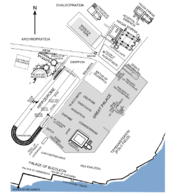Milion
The Milion ( Greek Μίλ (λ) ιον ) was a monument and a milestone in one. It was erected in Constantinople (now Istanbul , Turkey ) in the early 4th century AD . The Milion was the starting point of all measurements for milestones on roads leading to the important cities of the Eastern Roman Empire and had the same function as the Milliarium Aureum of Rome .
The vaulted building of the Milion supported four great arches and was adorned with numerous statues and paintings. It survived the Ottoman conquest of Constantinople (1453) for fifty years, but disappeared at the beginning of the 16th century. During excavations in the 1960s, fragments of the Milion were found under the houses in the area.
location
The remains of the building are located in Istanbul in the Eminönü district, near the Cağaloğlu district , on the north corner of the square in front of Hagia Sophia by the Basilica Cistern .
History and description
When Emperor Constantine the Great expanded the city of Byzantium into his new capital (which he called Nova Roma ("New Rome"), he deliberately imitated many of the institutions of "ancient Rome". The Milion can also be seen in this context: It had the shape of a tetrapylon crowned by a dome and was built in the first region of the city, near the old Constantinian Wall , at the very beginning of the main axis of the city, the Mese (Μέση Οδός) that made a curve at that point. The new building performed the same function as the Milliarium Aureum in Rome : It was regarded as the zero point of all roads leading to the European cities of the Eastern Roman Empire , and the distances to all important cities of the empire were indicated on its base. The monument was located directly east of the Augustaion and was much more complex than its counterpart in Rome. It can be seen as a double triumphal arch crowned by a dome supported by four arches . The milion was crowned by the statues of Constantine and his mother Helena , and a cross between the two statues that faced east. A statue of the city's Tyche stood between them.
From the beginning of the sixth century, the building became more and more important for the imperial ceremony. Justinian I added a sundial to it, Justin II decorated the lower part with statues of his wife Sophia , his daughter Arabia and his niece Helena . The monument was also decorated with equestrian statues of Trajan , Hadrian , Theodosius II and a bronze quadriga of Helios .
During the first half of the eighth century, the vaults of the building were decorated with paintings from past ecumenical councils by Emperors Philippikos Bardanes and Anastasios II , but during iconoclasm , Emperor Constantine V had them painted over with scenes from the hippodrome .
During the Comnene Age , the Milion was the site of battles such as the Milion, due to its strategic location in the city. B. that between Nikephoros III. and Alexios I , or those between imperial troops and the Empress Maria of Antioch , who controlled the Augustaion from this point of view.
In the period between 1268 and 1271, after the end of the Latin Empire , the Milion - together with the Augustaion - became the property of the Church of Hagia Sophia .
After the Ottoman conquest of Constantinople (1453), the building remained intact until the end of the 15th century. It may have disappeared at the beginning of the sixteenth century with the expansion of the Valens aqueduct and the construction of the suterazi ( Turkish : " water tower ", literally "water ladder ").
During excavations in 1967/68, the foundation and a fragment (now erected as a column) of the Milion were uncovered.
literature
- Raymond Janin : Constantinople Byzantine . Institut Français d'Etudes Byzantines, Paris 1950.
- Wolfgang Müller-Wiener: Pictorial dictionary on the topography of Istanbul: Byzantion, Konstantinupolis, Istanbul up to the beginning of d. 17 century . Wasmuth, Tübingen 1977, ISBN 978-3-8030-1022-3 .


